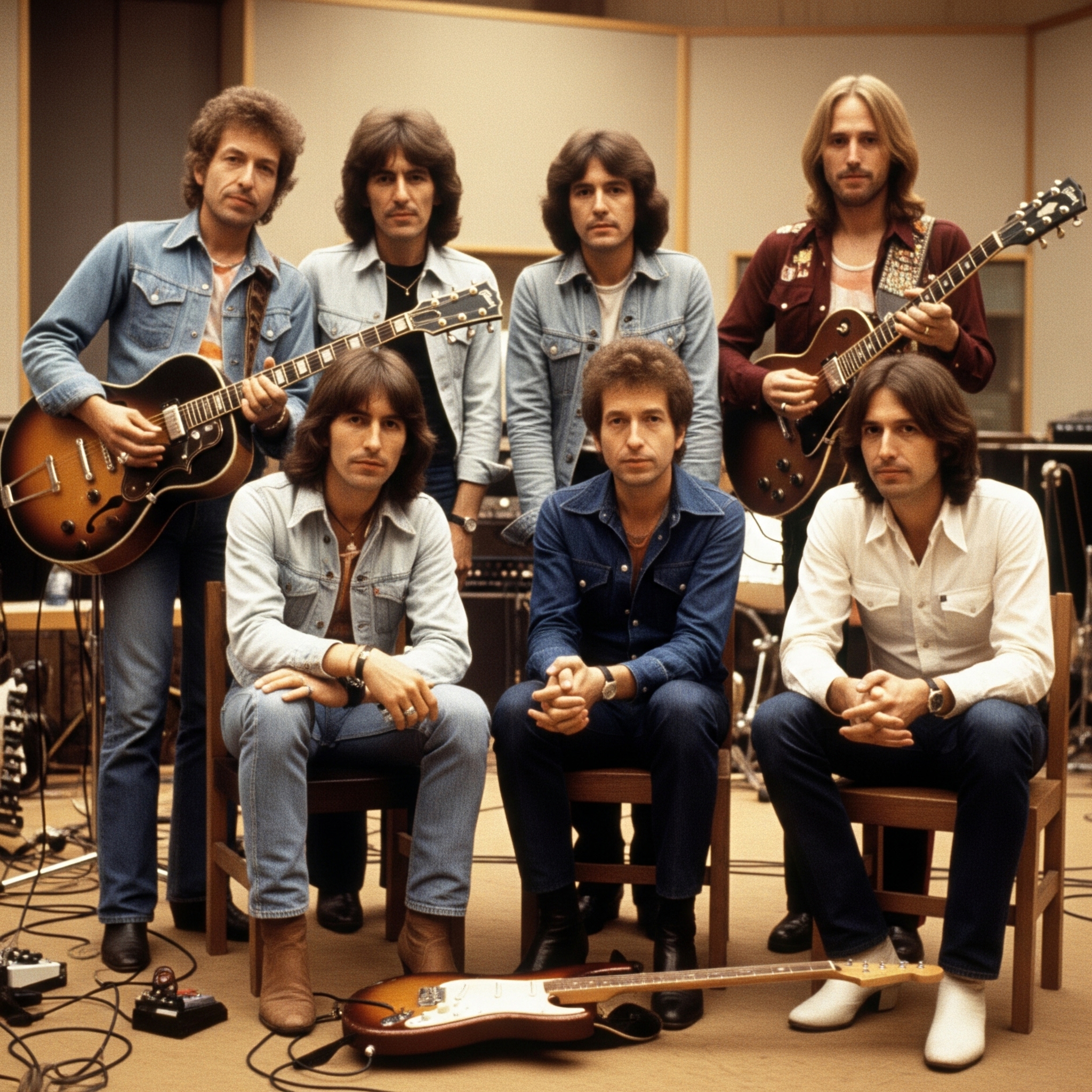The Traveling Wilburys Albums: A Supergroup Retrospective

The Traveling Wilburys Albums: A Supergroup Retrospective
Few musical projects capture lightning in a bottle quite like the Traveling Wilburys. Formed by five legends—Bob Dylan, George Harrison, Jeff Lynne, Roy Orbison, and Tom Petty—this supergroup created a sound that blended heart, humor, and heritage. In this retrospective, we explore the Traveling Wilburys albums and their lasting legacy.
Your questions answered;
Who were the Traveling Wilburys? The Traveling Wilburys were a rock supergroup composed of iconic musicians from the 1960s and 70s. Each member used a pseudonym and adopted a fictional Wilbury family persona. They shared songwriting, vocals, and instrumentation, resulting in a collaborative sound rooted in rock, folk, and pop.
How did the Traveling Wilburys get together? The group formed spontaneously in 1988 when George Harrison needed a B-side track. He gathered Jeff Lynne, Bob Dylan, Roy Orbison, and Tom Petty at Dylan's studio. What began as a casual session quickly turned into a full-fledged project.
Why didn't the Traveling Wilburys tour? The Wilburys never toured due to scheduling conflicts and the members' individual commitments. Their collaborative project was always intended as low-pressure and studio-based.
What was the creative process like for the Traveling Wilburys? Their process was informal and democratic. They wrote songs together in the studio, often building on spontaneous ideas. Each member contributed equally, keeping egos in check.
The Albums
Traveling Wilburys Vol. 1 (1988)

Released in October 1988, Traveling Wilburys Vol. 1 marked the beginning of one of the most unexpected musical collaborations of the decade. The Traveling Wilburys albums began with this debut, which combined folk-rock warmth, pop sensibility, and lyrical charm. The sound remained relaxed yet polished, thanks in large part to Jeff Lynne's production style. Although all members contributed, Orbison's soaring vocals and Harrison's steady rhythm gave the album its unique identity.
Commercially, it performed exceptionally well. It went triple platinum in the U.S. and topped charts worldwide. Critics praised its sincerity, playfulness, and melodic craftsmanship. Songs like "Handle with Care" and "End of the Line" became instant classics, further cementing the album’s appeal. The collaborative nature shone throughout, as each track featured shared vocals and rotating lead roles.
From a thematic perspective, it embraced camaraderie, reflection, and storytelling. Furthermore, the album highlighted each member's strengths without overshadowing the group dynamic. The success of Traveling Wilburys Vol. 1 proved that even rock icons could still surprise fans.
Importantly, the album reignited interest in all five artists, especially Roy Orbison, who sadly passed away shortly after its release. His contributions brought emotional depth and legacy to the project.
The Traveling Wilburys albums started with a high bar. This debut remains one of the most celebrated and influential records of the late 1980s. It not only introduced a new musical entity but also reminded fans of the enduring power of collaboration.
Traveling Wilburys Vol. 3 (1990)

Released in October 1990, Traveling Wilburys Vol. 3 served as the second and final studio release from the band. Ironically titled as the third volume, the album continued the unique sound introduced in the previous release. However, this time the dynamic shifted. The absence of Roy Orbison changed the vocal balance, giving more space to Dylan, Harrison, and Petty.
Musically, the album leaned further into rock territory, though it retained the pop-folk sensibilities of its predecessor. The production remained tight and cohesive, again guided by Jeff Lynne. Critics responded with mixed reviews at first. Some felt the energy dipped slightly without Orbison, but many praised the evolved sound and lyrical wit.
Songs like "She's My Baby" and "Inside Out" gained radio play and highlighted the group’s playful side. Although it didn’t match the first album's commercial heights, it achieved gold status and maintained the band's popularity.
Thematically, Vol. 3 reflected maturity, humor, and resilience. The artists addressed change—both musically and personally—without losing their collective spark. Importantly, the album reaffirmed their commitment to the project, even after the loss of a core member.
The Traveling Wilburys albums showed growth with this release. While less commercially explosive, it provided fans with a more grounded, unified sound. The decision to skip "Vol. 2" added to the band’s quirky mythos, reflecting their lighthearted approach.
Ultimately, Traveling Wilburys Vol. 3 reinforced the idea that even in transition, creativity could thrive. It remains a valued part of the Traveling Wilburys discography and a testament to their enduring camaraderie.
The Traveling Wilburys Collection (2016)

Released in June 2016, The Traveling Wilburys Collection compiled the group’s core work into a single, comprehensive box set. This package included both Vol. 1 and Vol. 3, along with rare tracks, demos, and a DVD with behind-the-scenes footage. For longtime fans and newcomers alike, it offered an accessible way to appreciate the full scope of the Traveling Wilburys albums.
From a genre standpoint, the Collection preserved the band’s hybrid sound—a mix of rock, folk, and pop rooted in late-20th-century traditions. Key tracks such as “Maxine” and “Like a Ship” added depth and context to the band’s evolution. These bonus songs revealed more about their relaxed, spontaneous recording sessions.
Critics praised the Collection for its quality remastering and thoughtful curation. It reignited appreciation for a band that had not released new material in decades. Commercially, it charted well in several countries and boosted digital streaming of their classic tracks.
The themes of legacy, brotherhood, and nostalgia run throughout this compilation. Collaborators such as Jim Keltner and Dhani Harrison contributed to the Collection’s expanded content and remastering. Their involvement ensured authenticity and preserved the original spirit of the music.
The Traveling Wilburys albums gain renewed context through this release. It unifies their work into a narrative arc, reinforcing how the project transcended its casual origins. While no new songs were recorded, the additional material provided insight into their process and chemistry.
Ultimately, The Traveling Wilburys Collection stands as a final chapter. It honors a supergroup that prioritized joy, musical freedom, and friendship above all else. For those exploring the Traveling Wilburys albums today, this collection remains the most complete experience available.
the Traveling Wilburys albums highlight what’s possible when great artists collaborate with joy and purpose. Though brief, their run delivered lasting impact. From the charm of Vol. 1 to the depth of Vol. 3, and finally the completeness of the 2016 Collection, each release offers something unique. Together, they remain a vital part of rock history.
One thought on “The Traveling Wilburys Albums: A Supergroup Retrospective”
Add a Comment Cancel reply
Recent Posts
Queen studio albums: A Review
Phil Collins Albums Ranked & Reviewed – Complete Guide to Every Studio Album
The best of Massive Attack
Let’s Make Magic
Book Your Event DJ Now





Hello there! I coild have sworn I’ve been to this blog
before but after checking through some of thhe post I realized it’s nnew to
me. Anyhow, I’m definitely delighted I found it and I’ll be book-marking annd checking back often! https://www.waste-NDC.Pro/community/profile/tressa79906983/